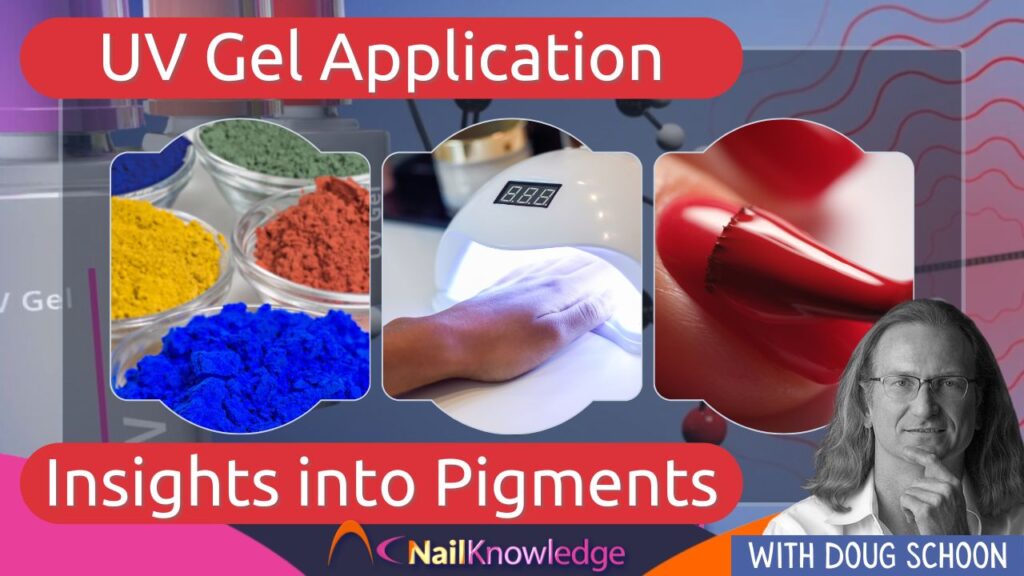In the realm of nail artistry, UV gel has revolutionised the way we approach nail enhancements. Its versatility, durability, and ability to create stunning designs have made it a favourite among nail professionals and enthusiasts alike. However, achieving flawless results with UV gel requires more than just skilful application. It involves understanding the intricate interplay between the gel, UV light, and pigments.
Join us as we uncover some of the science behind UV gel application, shedding light on the crucial factors that influence its curing process and the role pigments play in achieving optimal results.
UV Absorption in UV Gel Application
UV gel application is a meticulous process that hinges on the interaction between the gel and UV light. As a type of resin applied to the nail plate, UV gel undergoes a transformative journey under the influence of UV light. During the curing process, both the UV gel itself and the pigments within it eagerly absorb the UV light emitted by the curing lamp. This absorption sets off a cascade of chemical reactions within the gel, catalysing its cross-linking and solidification. The end result? A resilient and long-lasting coating that adheres seamlessly to the nail, showcasing the beauty and durability of UV gel manicures.
In addition to the UV gel, pigments may be added to the gel to create desired colours or effects. These pigments also absorb UV light during the curing process. As the UV light penetrates the gel, it interacts with the pigments, causing them to absorb the UV energy. This absorption of UV light by the pigments may affect the curing process and the final appearance of the nail coating.
Unveiling the Secrets of Pigments in UV Gel
Pigments play a vital role in the world of UV gel manicures, offering endless possibilities for creativity and expression. These colourful additives are incorporated into UV gel formulations to enhance their aesthetic appeal, allowing nail artists to create stunning designs and vibrant hues. From rich reds to deep blues, pigments come in a variety of shades and formulations, each offering its own unique characteristics and effects. But beyond their visual allure, pigments also influence the curing process of UV gel, affecting its opacity, consistency, and overall performance on the nail.
Diving Deep into Pigment Absorption: Understanding Colour Dynamics in UV Gel Manicures
Exploring Pigment Absorption in UV Gel
In the realm of UV gel manicures, pigments are the palette with which nail artists paint their masterpieces. These tiny particles, infused within the gel, hold the power to transform nails into stunning works of art. But beyond their vibrant hues and captivating shades lies a fascinating phenomenon: pigment absorption.
Pigments within UV gel, particularly shades like red and black, possess a unique ability to absorb UV light with greater efficiency compared to lighter colours such as white or blue. This heightened absorption not only intensifies the colour saturation but also influences the curing process of the gel.
Furthermore, regardless of their specific hue, all pigments create what can be described as an “umbrella effect.” As UV light penetrates the layers of gel, pigments cast a subtle shade on the layers beneath them, altering the distribution of light and affecting the overall curing process.
The Impact of Pigment Load on UV Gel Curing
The pigment load in UV gel plays a significant role in the curing process, with higher pigment concentrations presenting potential challenges. As the pigment load increases, more UV light is absorbed by the pigments themselves, thereby reducing the amount of light that penetrates through to the gel for proper curing. This phenomenon exacerbates the under-curing issue, as insufficient UV exposure leads to incomplete polymerisation, compromised durability and increased potential for adverse skin reactions.
Nail professionals must carefully consider the pigment load in UV gel formulations to ensure optimal curing and long-lasting results. The only way for nail professionals to manage pigment load is by curing longer to ensure proper curing and applying thinner layers.
Navigating the Risks of Adding Nail Art Pigments to UV Gel
While the addition of nail art pigments can elevate the aesthetic appeal of UV gel manicures, it also introduces inherent risks that must be navigated with caution. One such risk is the increase in pigment load, which amplifies the likelihood of under-curing due to UV absorption by the pigments. As more UV light is absorbed by the pigments, less reaches the deeper layers of gel for proper curing, leading to premature wear and increased potential for adverse skin reactions. Nail artists must strike a delicate balance between creativity and practicality when incorporating pigments into UV gel formulations, prioritising proper curing techniques and product compatibility to mitigate the risks associated with pigment addition.


